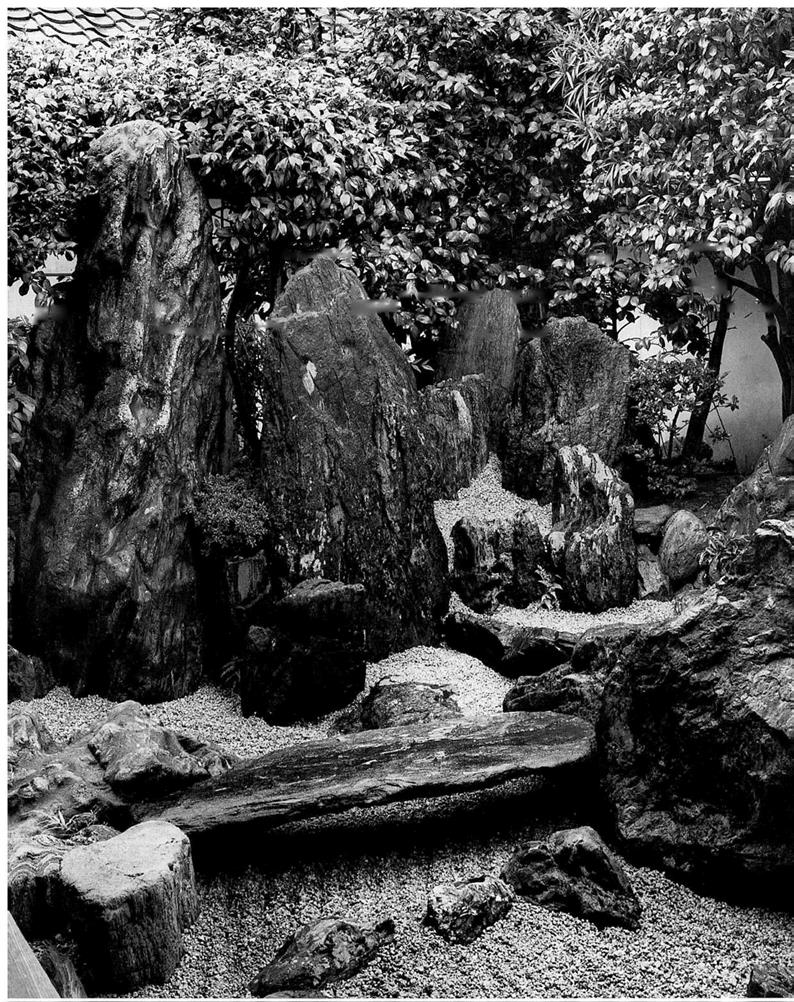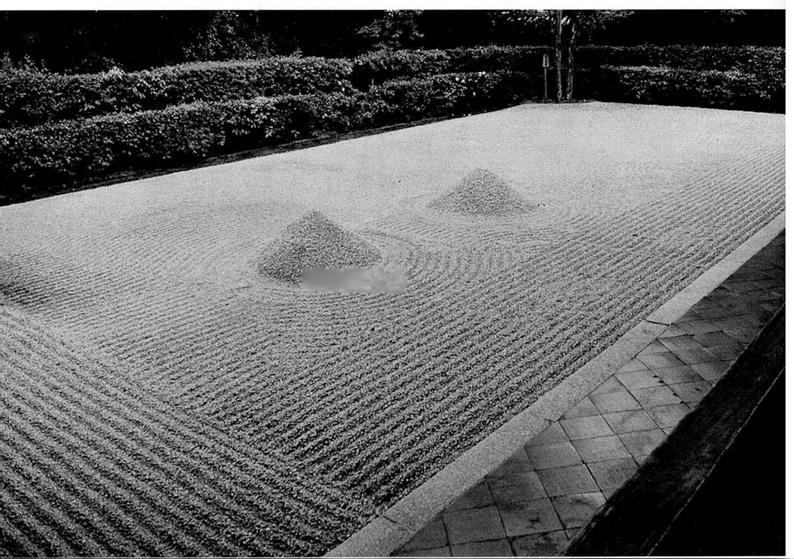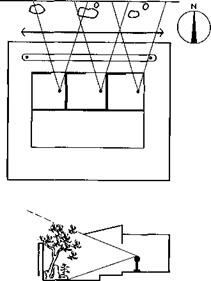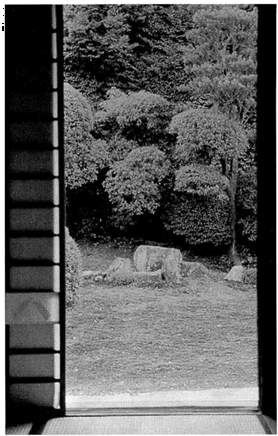In the late Heian period, the most significant change to occur in shinden-zukuri architecture was the division of the interior of the shinden, directly under the roof ridge, into north and south halves partitioned by sliding doors (munewakedo). The south side (hare) served as the formal ceremonial space, and the north side (ke) was for daily living. The residential area was further divided by fixed walls and fusuma sliding doors into small rooms—specifically, the study, the sleeping room and the informal reception room, or shoin (Figure 17). This grouping of rooms along

18.1 Dry waterfall and rapids of the north garden at Daitokuji Daisen’in, Kyoto.
|
|
|


18.3 The Daisen’in hojo south garden.
 19.1 Plan and section schematics showing views afforded of the north garden through the halfbay openings from the adjacent small rooms along the building’s north side and the lateral path of movement on the veranda.
19.1 Plan and section schematics showing views afforded of the north garden through the halfbay openings from the adjacent small rooms along the building’s north side and the lateral path of movement on the veranda.
the north side naturally stimulated new approaches to garden design, and is thought to be a factor in the characteristic density of the north garden.
Shinden-zukuri architecture originally had no fixed partitions. When the shitomido shutters were raised, the palace and garden were unified, providing a panoramic overview of the entire garden and architectural environment. With the shift to the partitioning of interior space into rooms beginning in the twelfth century, the panoramic field of vision achieved with shinden-zukuri architecture was narrowed to a more acute angle. An additional change in exterior fixtures from shitomido swinging shutters to mairado sliding doors enhanced this tendency.
As opposed to shitomido, which swing up on a horizontal pivotal axis, leaving the entire one-bay space between columns open, mairado are composed of two wooden doors and one paper screen (akarishoji) that slide horizontally in a three-track gutter, so that even in their fully open position a half-bay section always remains closed to the outdoors (see Figures 36.1-36.2). The result is a framed, or cropped, view of a single scene of the garden. The relationship between the garden and the series of rooms with narrowed views gave rise to the unique characteristics of the north garden; the views from inside the rooms demand a garden of considerable density.
Of all the basic compositional elements of the prototypical shinden-zukuri garden, the waterfall and rapids of the upper garden stream were best expressed in the high – density north garden. The theme of the gardens of Daitokuji’s Daisen’in and Myoshinji’s Taizo-in is the “flow” of the garden stream from the water’s source—a mountain waterfall with cascading water that flows over,
under, and around dams, bridges, and islands, finally exiting under the building, creating an implied continuous flow that pours out into the “open sea” garden on another side of the building (Figures 18.1-18.3). The interpretations for these small narrow strip gardens less than four meters (twelve feet) in depth, replace water with moss and coarse white sand, creating an exquisite, abstract expression of the prototype.
Another compositional characteristic of the north garden was a quality of linear continuity born of the moving vantage point afforded the viewer walking the north veranda. The interactive relationship between the garden and viewer walking on the veranda was an important factor in the changeover during this period to kinetic and bidirectional garden composition techniques.
The garden scenes relating to the views afforded from floor-level seated positions inside the individual adjoining rooms had to be linked so as to create a unified garden that would flow in a linear sequential fashion as the viewer walked along the veranda. The north garden preserved the frontal, single-scene compositions that correspond to fixed vantage points from the room interiors, but at the same time linked one focal point to another, giving the garden a dual composition (Figures 19.1-19.3).
The compositional technique used to bring the spaces between individual garden scenes into play via movement and form a unified garden bears a close resemblance to Sesshu’s horizontal handscroll entitled Sansui chokan (Landscape, 1486), in which a series of single scenes are linked into a unified scroll painting through the use of a technique called zansanjosui.
Zansan josui is frequently used in ink-wash landscape
 |
 |
painting to suggest mountains and water slowly receding into the “mist,” comprised of segments of white space left open between scenes, linking them into one integrated scroll. This expanse of unarticulated paper is not empty space, but ma. The term “ma,” as used in traditional Japanese performing and visual arts, describes an interval in time or space—a void that by its very absence (whether of sound or of form) asserts its existence, adding to the articulation of the overall space. In Muromachi-period north gardens and ink-wash landscape scrolls, ma is an unimposing space that allows for the impression made by the previous scene to fade naturally away (Figures 20.1-20.2).
Just as Heian-period yamato-e paintings—in which well-known scenes from the four corners of the capital and the four seasons had been linked by the kumogasumi (cloud and mist) technique on a single, all-encompassing picture plane related to the panoramic view of the shin – den-zukuri garden from the palace, the composition of the Muromachi-period north garden was expressed with techniques similar to those used in the ink-wash landscape paintings popular during the same period.
The zatisan josui technique is adaptable to a garden
composed of linked heterogeneous spaces, where each scene is hidden from the next and appears in linear succession, but not to a landscape that can be apprehended in a single sweeping view.



